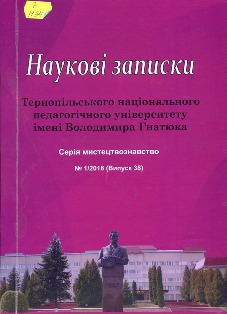СИМВОЛІЧНИЙ ЛАНДШАФТ У ГРАФІЧНОМУ ДИЗАЙНІ РАДЯНСЬКОЇ УКРАЇНИ ТА УКРАЇНСЬКОЇ ДІАСПОРИ (1945–1989 РОКИ)
Ключові слова:
графічний дизайн, символічний ландшафт, Радянська Україна, українська діаспораАнотація
На прикладах українського радянського плакату й обкладинок періодичних видань діаспори 1945–1989 рр. розглянуто символічні зображення України за допомогою ландшафту. З’ясовано, що міський та сільський ландшафти в обидвох випадках представлено відповідно до ідеологічного контексту. Радянські приклади наголошували на модернізації останніх років і символічно показували майбутнє. Діаспорні твори переповнені ностальгією за минулим та
зображають ідеальні позачасові картини. Визначено, що символіка ландшафту пов’язана не стільки з реальним середовищем, як із різними візіями національної ідентичності.
Посилання
Butovych, M. (1958), Letter to the Bandurist Chorus concerning the commission of an emblem and a stamp. Archive of The Ukrainian Museum and Library in Stamford. Folder: Butovych, Mykola. Correspondence 1950–1961. (іn Ukrainian).
Radysh, O. and Kosiv, V. (2015, October 12). Interview with O. Radysh, New York. Author’s archive. (in Ukrainian).
Anderson, B. (1983). Imagined Communities, London, Verso. (in English).
Cash, J. R. (2007), Origins, Memory, and Identity: “Villages” and the Politics of Nationalism in the Republic of Moldova, East European Politics and Societies, 21, No. 4, pp. 588–610. (in English).
Cohn, J. (1979), The Palace or the Poorhouse: The American House as a Cultural Symbol, East Lansing, The Michigan State University Press. (in English).
Eco, U. (1986), Function and Sign: Semiotics of Architecture. In The City and the Sign. An Introduction to Urban Semiotics [Edited by M. Gottdiener and Alexandros Ph. Lagopoulos], New York, Columbia University Press, pp. 55–86. (in English).
French, R. A. and Hamilton I. (1979), Is There a Socialist City? In The Socialist City: Spatial Structure and Urban Policy [Edited by R. A. French and F. E. Ian Hamilton], Chichester–New York–Brisbane–Toronto, John Wiley & Sons, pp. 1–21. (in English).
Grudzinska Gross, I. (1991), Saint Basil’s Cathedral as a Symbol of the Otherness of Russia. In Comparative Literature Studies, 28, No. 2, pp. 178–188. (in English).
Halink, S. (2014), The Icelandic mythscape: sagas, landscapes and national identity. In National Identities, Vol. 16:3, pp. 209–223. (in English).
Jolivette, C. (2003), The “Britishness of British Art”: Landscape, Art and Identity, 1951–1956. PhD Dissertation in Art History. The Pennsylvania State University. (in English).
Larsen, S. E. (2005), The national landscape – national identity or post-colonial experience? In European Review, 13, no. 2, pp. 293–303. (in English).
O’Neill, B. (2009), The political agency of cityscapes: Spatializing governance in Ceausescu’s Bucharest, In Journal of Social Archaeology, 9 (1), pp. 92–109. (in English).
Osborne, B. S. (1988), The iconography of nationhood in Canadian Art. In The Iconography of Landscape. Essays on the symbolic representation, design and use of past environments [edited by Denis Cosgrove and Stephen Daniels], Cambridge, Cambridge University Press, pp. 162–178. (in English).
Stoklund, B. (1999). How the Peasant House Became a National Symbol. A Chapter in the History of Museums and Nation-Building. In Ethnologia Europea, 29, pp. 5–18. (in English).

